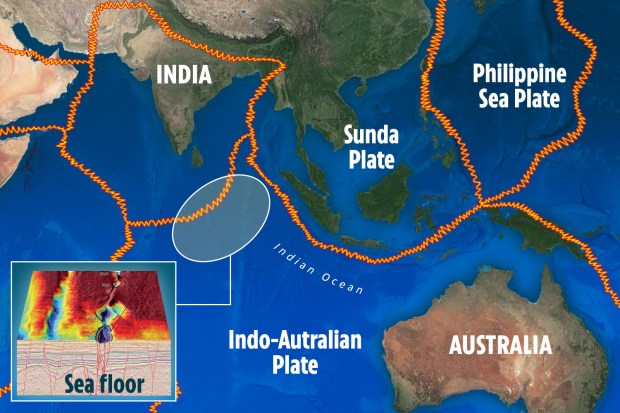Giant tectonic plate between Australia and India SPLITTING apart – threatening millions of years of severe earthquakes

A GIANT tectonic plate under the Indian Ocean is slowly breaking in two, according to a new study.
Tectonic plates cover the Earth like a patchwork quilt and their movement can trigger devastating earthquakes.
In geological terms the plate is expected to split in a short time but to humans the breakup will last an eternity.
The India-Australia-Capricorn tectonic plate is thought to be moving apart by 0.06 inches (1.7 millimeters) a year.
At that pace, it will take one million years for the pieces to be one mile apart.
According to , study co-researcher Aurélie Coudurier-Curveur said: "It's not a structure that is moving fast, but it's still significant compared to other planet boundaries."
The plate is splitting so slowly and is so far underwater that researchers almost missed what was happening.
However, two strong earthquakes that originated in an unusual spot in the Indian Ocean indicated that some changes to the Earth's crust were occurring.
These earthquakes occurred on April 11, 2012 beneath the ocean near Indonesia.
Scientists found it strange that the earthquakes didn't originate from two tectonic plates rubbing against each other but from the middle of one plate.
This wasn't a complete surprise though as the the India-Australia-Capricorn plate doesn't always work as one cohesive unit.
Coudurier-Curveur told : "It's like a puzzle. It's not one uniform plate.
"There are three plates that are, more or less, tied together and are moving in the same direction together."
A recent study looked at a section of the plate known as the Wharton Basin as this is where the earthquakes originated.
They used a technique which measured how long sound waves took to bounce off the ocean floor to map out the landscape beneath the surface.
When they looked back at the data they noticed "pull-aparts" or "trike-slip faults", which are areas on a plate that can cause earthquakes when they slide past each other horizontally.
This can be visualised by putting your fists together and sliding them back and forth.
The team found 62 of these pull-apart regions along a mapped fracture zone, spanning 217 miles.
Some of these areas were huge, measuring up to five miles long and 1.8 miles wide.
Others are thought to be 120 metres deep.
Scientists think these gaps started forming around 2.3million years ago along a line that passed through the epicentres of the 2012 earthquakes.
William Hawley, a seismologist who wasn't involved in the study, told : "It doesn't seem like it's yet a fully formed plate boundary.
"But the take-home message is that it's becoming one, and it probably accounts for much of the deformation that we know is occurring there."
If these pull-apart areas do turn into a full on fracture there's still no need to panic as the researchers think the fracture zone won't result in another earthquake for 20,000 years.
However, these strong earthquakes might start occurring every 20,000 years as the fracturing continues.
It's also likely to take tens of millions of years before the split is complete.
This study has been published in the journal the journal .
What causes earthquakes?
Here's everything you need to know...
- An earthquake is a shockwave caused by rocks being under extreme forces
- They are typically triggered by the movement of Earth's crust
- Earth's tectonic plates, the massive shelves of crust that carry the continents and seafloor, meet at points called fault lines
- When these plates rub over or against one another, huge amounts of pressure are generated
- This creates shockwaves that send violent vibrations through Earth
- The shock can split the planet's crust and create devastating tsunamis
Most read in Science
In other news, Nasa scientists thought they may have found evidence of a bizarre parallel universe but now other experts are castings doubts.
Climate change could render a fifth of the planet as hot as the Sahara Desert by 2070, according to a new study.
Read More on The Sun
And, these shocking climate change photos reveal the devastating impact of global warming around the world.
What do you make of this tectonic plate discovery? Let us know in the comments...
We pay for your stories! Do you have a story for The Sun Online Tech & Science team? Email us at tech@the-sun.co.uk

















